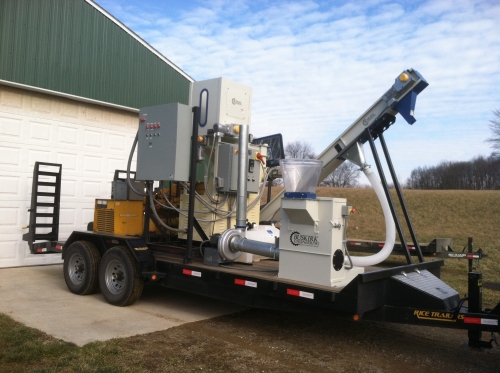Portable Pellet Mill
Biomass from various sources can be pelletized and used for combustion to generate heat or electricity. One of the key issues with hanlding biomass is that it is very loose and low density. We have 5 corn ethanol plants in Michigan making ethanol from corn grain. Corn kernals are about 4.5 times more dense. In order to be efficient in transportation, storage and handling costs, biomass will need to be densified in some way. This mobile unit allows us to conduct on farm demonstrations as well as research on binding agents, throughput and pellet durability of various feedstocks.
Biomass is fed into the hammermill (clear cylindrical item at front of trailer) and ground to pass through a 1/4 inch sieve. It is then blown into a holding tank, called a surge bin. An auger at the bottom of the surge bin pulls ground material out where it drops into the pellet mill. Pellets come out of the machine and drop into the conveyor. The convey is hooked up to the blower to pull air in, which cools the pellets. It also picks up any fines and blows them back into the surge bin. There is a large clyclone mounted on top of the surge bin that recycles dust from throughout the system.
The pellet mill is a ring die. This means the die spins and rollers are stationary, forcing the material through the die. Different types of biomass require different thickness of die's. For switchgrass, you want a 10:1 ratio between the thickness of the die and the size of the pellet. For a 1/4 inch diameter pellet, you will want a die that is 2 1/2 inches thick.




 Print
Print Email
Email